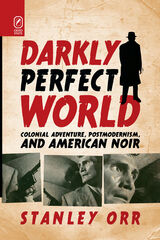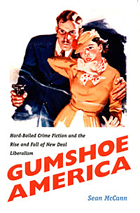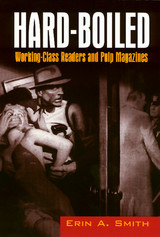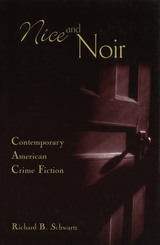5 books about Noir fiction, American

Darkly Perfect World
Colonial Adventure, Postmodernism, and American Noir
Stanley Orr
The Ohio State University Press, 2010
Stanley Orr’s Darkly Perfect World offers a large-scale historical narrative about the way American crime fiction and film have changed throughout the twentieth century. Orr argues that films noirs and noir fictions dramatize Raymond Chandler’s pronouncement that “Even in death, a man has a right to his own identity.” Orr illuminates a noir ethos committed to “authenticating alienation”: subjectivity managed through radical polarization of Self and Other. Distinguishing a heretofore unrecognized context for American noir, Orr demonstrates that Chandler and Dashiell Hammett arrive at this subject within and against the colonial adventure genre. While the renegades of Joseph Conrad and Louis Becke project a figure vulnerable to shifts in cultural context, the noir protagonist exemplifies alienated selfhood and often performs a “continental operation” against the slippages of the colonial adventurer. But even as Orson Welles, Billy Wilder, and other noir virtuosi persist with this revision of late Victorian adventure, Chester Himes, Dorothy Hughes, and John Okada experiment with hard-boiled alienation for a subversion of noir that resonates throughout literary postmodernism. In their respective avant-garde novels, Thomas Pynchon, Ishmael Reed, and Paul Auster expose what K.W. Jeter terms the “darkly perfect world” of noir, thus giving rise to and enabling the con men and “connected guys” of contemporary films noirs such as Bryan Singer’s The Usual Suspects, David Fincher’s Seven, Christopher Nolan’s Memento, and Quentin Tarantino’s Reservoir Dogs.
[more]

Gumshoe America
Hard-Boiled Crime Fiction and the Rise and Fall of New Deal Liberalism
Sean McCann
Duke University Press, 2000
In Gumshoe America Sean McCann offers a bold new account of the hard-boiled crime story and its literary and political significance. Illuminating a previously unnoticed set of concerns at the heart of the fiction, he contends that mid-twentieth-century American crime writers used the genre to confront and wrestle with many of the paradoxes and disappointments of New Deal liberalism. For these authors, the same contradictions inherent in liberal democracy were present within the changing literary marketplace of the mid-twentieth-century United States: the competing claims of the elite versus the popular, the demands of market capitalism versus conceptions of quality, and the individual versus a homogenized society.
Gumshoe America traces the way those problems surfaced in hard-boiled crime
fiction from the1920s through the 1960s. Beginning by using a forum on the KKK in the pulp magazine Black Mask to describe both the economic and political culture of pulp fiction in the early twenties, McCann locates the origins of the hard-boiled crime story in the genre’s conflict with the racist antiliberalism prominent at the time. Turning his focus to Dashiell Hammett’s career, McCann shows how Hammett’s writings in the late 1920s and early 1930s moved detective fiction away from its founding fables of social compact to the cultural alienation triggered by a burgeoning administrative state. He then examines how Raymond Chandler’s fiction, unlike Hammett’s, idealized sentimental fraternity, echoing the communitarian appeals of the late New Deal. Two of the first crime writers to publish original fiction in paperback—Jim Thompson and Charles Willeford—are examined next in juxtaposition to the popularity enjoyed by their contemporaries Mickey Spillane and Ross Macdonald. The stories of the former two, claims McCann, portray the decline of the New Deal and the emergence of the rights-based liberalism of the postwar years and reveal new attitudes toward government: individual alienation, frustration with bureaucratic institutions, and dissatisfaction with the growing vision of America as a meritocracy. Before concluding, McCann turns to the work of Chester Himes, who, in producing revolutionary hard-boiled novels, used the genre to explore the changing political significance of race that accompanied the rise of the Civil Rights movement in the late 1950s and the 1960s.
Combining a striking reinterpretation of the hard-boiled crime story with a fresh view of the political complications and cultural legacies of the New Deal, Gumshoe America will interest students and fans of the genre, and scholars of American history, culture, and government.
Gumshoe America traces the way those problems surfaced in hard-boiled crime
fiction from the1920s through the 1960s. Beginning by using a forum on the KKK in the pulp magazine Black Mask to describe both the economic and political culture of pulp fiction in the early twenties, McCann locates the origins of the hard-boiled crime story in the genre’s conflict with the racist antiliberalism prominent at the time. Turning his focus to Dashiell Hammett’s career, McCann shows how Hammett’s writings in the late 1920s and early 1930s moved detective fiction away from its founding fables of social compact to the cultural alienation triggered by a burgeoning administrative state. He then examines how Raymond Chandler’s fiction, unlike Hammett’s, idealized sentimental fraternity, echoing the communitarian appeals of the late New Deal. Two of the first crime writers to publish original fiction in paperback—Jim Thompson and Charles Willeford—are examined next in juxtaposition to the popularity enjoyed by their contemporaries Mickey Spillane and Ross Macdonald. The stories of the former two, claims McCann, portray the decline of the New Deal and the emergence of the rights-based liberalism of the postwar years and reveal new attitudes toward government: individual alienation, frustration with bureaucratic institutions, and dissatisfaction with the growing vision of America as a meritocracy. Before concluding, McCann turns to the work of Chester Himes, who, in producing revolutionary hard-boiled novels, used the genre to explore the changing political significance of race that accompanied the rise of the Civil Rights movement in the late 1950s and the 1960s.
Combining a striking reinterpretation of the hard-boiled crime story with a fresh view of the political complications and cultural legacies of the New Deal, Gumshoe America will interest students and fans of the genre, and scholars of American history, culture, and government.
[more]

Hard-Boiled
Erin A. Smith
Temple University Press, 2000
In the 1920s a distinctively American detective fiction emerged from the pages of pulp magazines. The “hard-boiled” stories published in Black Mask, Dime Detective, Detective Fiction Weekly, and Clues featured a new kind of hero and soon challenged the popularity of the British mysteries that held readers in thrall on both sides of the Atlantic. In Hard-Boiled Erin A. Smith examines the culture that produced and supported this form of detective story through the 1940s.
Relying on pulp magazine advertising, the memoirs of writers and publishers, Depression-era studies of adult reading habits, social and labor history, Smith offers an innovative account of how these popular stories were generated and read. She shows that although the work of pulp fiction authors like Dashiell Hammett, Raymond Chandler, and Erle Stanley Gardner have become “classics” of popular culture, the hard-boiled genre was dominated by hack writers paid by the word, not self-styled artists. Pulp magazine editors and writers emphasized a gritty realism in the new genre. Unlike the highly rational and respectable British protagonists (Miss Marple and Hercule Poirot, for instance), tough-talking American private eyes relied as much on their fists as their brains as they made their way through tangled plotlines.
Casting working-class readers of pulp fiction as “poachers,” Smith argues that they understood these stories as parables about Taylorism, work, and manhood; as guides to navigating consumer culture; as sites for managing anxieties about working women. Engaged in re-creating white, male privilege for the modern, heterosocial world, pulp detective fiction shaped readers into consumers by selling them what they wanted to hear – stories about manly artisan-heroes who resisted encroaching commodity culture and the female consumers who came with it. Commenting on the genre’s staying power, Smith considers contemporary detective fiction by women, minority, and gay and lesbian writers.
Relying on pulp magazine advertising, the memoirs of writers and publishers, Depression-era studies of adult reading habits, social and labor history, Smith offers an innovative account of how these popular stories were generated and read. She shows that although the work of pulp fiction authors like Dashiell Hammett, Raymond Chandler, and Erle Stanley Gardner have become “classics” of popular culture, the hard-boiled genre was dominated by hack writers paid by the word, not self-styled artists. Pulp magazine editors and writers emphasized a gritty realism in the new genre. Unlike the highly rational and respectable British protagonists (Miss Marple and Hercule Poirot, for instance), tough-talking American private eyes relied as much on their fists as their brains as they made their way through tangled plotlines.
Casting working-class readers of pulp fiction as “poachers,” Smith argues that they understood these stories as parables about Taylorism, work, and manhood; as guides to navigating consumer culture; as sites for managing anxieties about working women. Engaged in re-creating white, male privilege for the modern, heterosocial world, pulp detective fiction shaped readers into consumers by selling them what they wanted to hear – stories about manly artisan-heroes who resisted encroaching commodity culture and the female consumers who came with it. Commenting on the genre’s staying power, Smith considers contemporary detective fiction by women, minority, and gay and lesbian writers.
[more]

New Hard-Boiled Writers
1970s–1990s
LeRoy Lad Panek
University of Wisconsin Press, 2000
Beginning in the 1970s, a new generation of writers took over the hard-boiled story (created by Raymond Chandler and Dashiell Hammett) and transformed it to fit the realities of their world—a universe infected by violence, greed, racism, sexism, war, and commercialism. Their protagonists, too, are far different from Sam Spade and Philip Marlowe.
The author comments both on the way the hard-boiled story has changed over the past three decades and examines the work of ten significant contemporary hard-boiled writers. Chapters on Robert B. Parker, James Crumley, Loren Estleman, Sara Paretsky, Sue Grafton, Carl Hiaasen, Earl Emerson, Robert Crais, James Lee Burke, and Walter Mosley demonstrate how these writers have used the hard-boiled hero to make powerful statements about life in the last quarter of the twentieth century.
The author comments both on the way the hard-boiled story has changed over the past three decades and examines the work of ten significant contemporary hard-boiled writers. Chapters on Robert B. Parker, James Crumley, Loren Estleman, Sara Paretsky, Sue Grafton, Carl Hiaasen, Earl Emerson, Robert Crais, James Lee Burke, and Walter Mosley demonstrate how these writers have used the hard-boiled hero to make powerful statements about life in the last quarter of the twentieth century.
[more]

Nice and Noir
Contemporary American Crime Fiction
Richard B. Schwartz
University of Missouri Press, 2002
Owners of mystery bookshops will tell you that there are several sorts of buyers: those who purchase on impulse or whim; genre addicts who buy paperbacks by the week and by the armful; and those who have caught up on canonical texts and regularly buy new novels by select authors in hardcover. Richard B. Schwartz belongs in the last group, with his own list of approximately seventy favorite writers.
Nice and Noir: Contemporary American Crime Fiction explores the work of these writers, building upon a reading of almost seven hundred novels from the 1980s and 1990s. By looking at recurring themes in these mysteries, Schwartz offers readers new ways to approach the works in relation to contemporary cultural concerns.
With sensitivity to a culture consisting of frontiers and borders, Schwartz examines the position of the vigilante in art and society, racial bridges and divides, the absence of divine presence and compensating narrative strategies, the unresolved nature of the crime plot and its roots in chivalric romance. The special importance of setting and the growing importance of grotesque humor in the fiction studied here are addressed by the author, as is the journalistic/instructional dimension of the field and the importance of crossover narratives.
This book is not only a study and appreciation of an important subgenre and its contemporary practitioners; it also utilizes both literary history and theoretical material. Information has been drawn from fanzines, from discussions with writers, booksellers, agents, and editors, and from the author’s own extensive knowledge of literature and American culture.
Nice and Noir is wide-ranging but neither ponderous nor lugubrious. Its language is accessible but not simplistic. The book will have a broad appeal—both to academics and to general readers with some interest in American studies and popular culture.
[more]
READERS
Browse our collection.
PUBLISHERS
See BiblioVault's publisher services.
STUDENT SERVICES
Files for college accessibility offices.
UChicago Accessibility Resources
home | accessibility | search | about | contact us
BiblioVault ® 2001 - 2024
The University of Chicago Press









